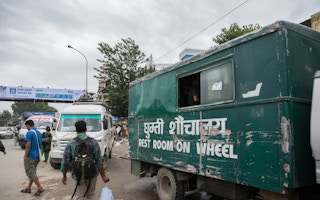Decent sanitation for all is crucial for rapidly urbanising Asia. Governments across the region recognise this and rely on “big sanitation” projects, like a piped sewerage network connecting to a centralised wastewater treatment plant.
The problem is that big sanitation projects often don’t reach the urban poor.
A paper I recently wrote on the leading factors for success and failure in ADB’s urban sanitation projects discussed the wider issue of how development banks can get more involved in supporting interventions to deliver sanitation services to the urban poor and, in doing so, achieve more inclusive sector outcomes.
For instance, development banks can encourage governments and municipal authorities to adopt a more comprehensive approach to their sanitation investments. High population density means poor and better-off areas are crammed together in many Asian cities, so it’s not hard to see how inadequate sanitation in poor areas can affect neighbouring communities through poor health and other impacts.
In Asia, where 46 per cent of the population is projected to be urban by 2020, sanitation solutions must include the poor.
Demonstration effects are powerful drivers for replicating and scaling up successful projects. ADB-supported small-scale on-site sanitation pilots at the municipal level in India’s Rajasthan state, Mongolia, and Nepal for fecal sludge management were designed for this very purpose, and are showing great promise for reaching poor or off-grid communities.
Not only does the proper collection, treatment, and disposal or reuse of waste contribute to better health and a cleaner environment, but these processes can create local jobs and business opportunities for entrepreneurs, such as in converting waste to biogas and fertiliser.
When governments see that these and similar projects by other organisations deliver benefits, they are more likely to invest public funds in both the on-site treatment of wastewater and big centralized systems. The need is certainly there in developing Asian countries, where only 45 per cent of the urban population is currently connected to a sewer system.
Some big cities in Southeast Asia, like Bangkok and Manila, rely on decentralised, on-site sanitation. Outside the region, a similar situation can be found in cities in Ghana, Kenya, and Peru.
For these systems to function, they need to be regularly maintained. Small-scale providers do this through septic tank emptying, waste recycling, and building latrines. This vital but largely unregulated sector receives little support.
A big push by development banks to support these actors through access to finance—for example, through concessionary loans and equity investments—and by using policy dialogue to regulate these services to raise their quality could be a game changer. Investments in sanitation need to be accompanied by national public hygiene campaigns, like India’s to stop open defecation.
“
The problem is that big sanitation projects often don’t reach the urban poor.
As well as heightening public awareness, these campaigns can put the spotlight on the need for central and local government to prioritise investments in sanitation, which can provide the private sector—including small businesses—with investment opportunities.
For development banks, getting involved in these campaigns is not only an opportunity to engage with government partners working in sanitation, but also for policy dialogue and capacity building in countries—or provinces or states—that aren’t doing these campaigns.
The ideal situation is having every house connected to a sewerage system. Rajasthan’s 2016 wastewater policy is for every household in the state to have access to a sewerage system within the next 30 years, and the authorities are pursuing both centralised and on-site solutions to achieve this.
As Rajasthan’s timeframe suggests, it will also likely take decades to achieve urban sanitation across developing Asia.
In the meantime, conventional big off-site sanitation operations, such as those that have been the mainstay of ADB’s sector support, will need to be increasingly complemented with interventions for small sanitation schemes targeting the poor. A good way to do this is for development banks to work with the global, national, and local organisations already engaged at this level.
Tomoo Ueda is Principal Evaluation Specialist, Independent Evaluation Department at the Asian Development Bank. This post is republished from the ADB blog.









